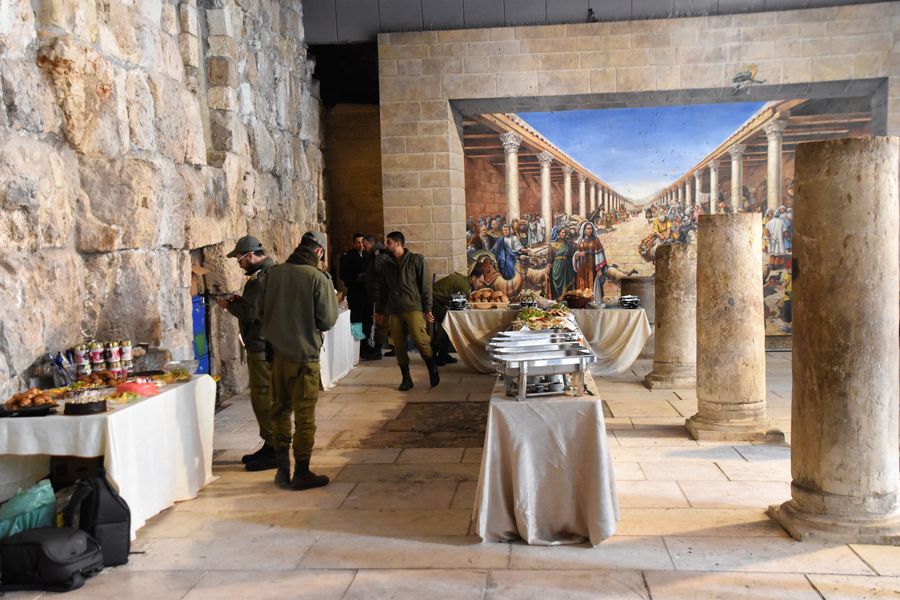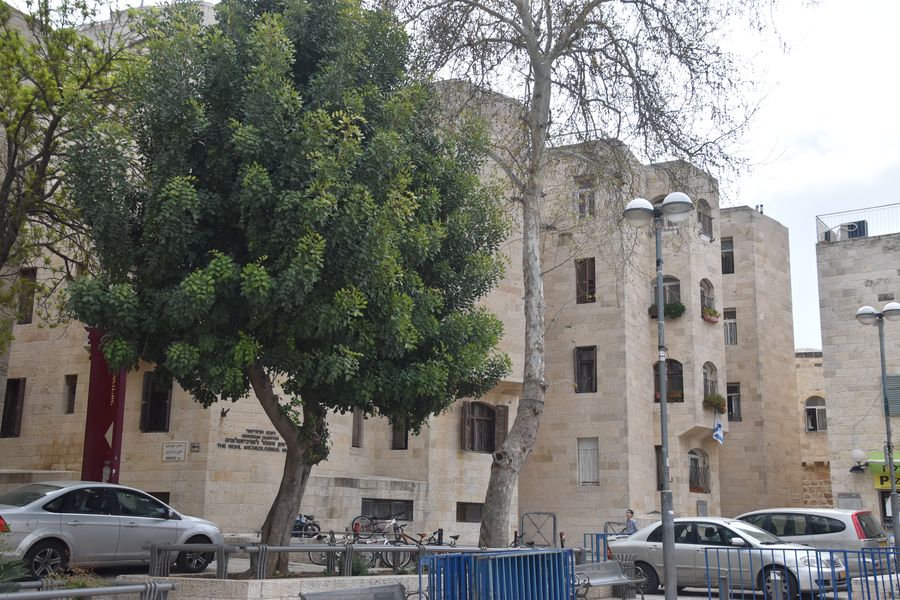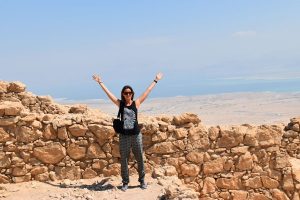01 May2017
15 things you will learn about Jerusalem on free Jerusalem Old City walking tour
During my second visit to Jerusalem, in March 2017 I decided to join a free Jerusalem Old City walking tour with Sandemans New Europe. This article is about the things I learned on the tour and found them interesting for Jerusalem first timers. Hopefully it will give you some insight into both Jerusalem Old City past and present.
15 things you will learn about Jerusalem on free Jerusalem Old City walking tour
1. We started at the Jaffa gate. Jaffa gate is the main gate out of the 8 gates in the Old City. However, the Muslims call it differently, not Jaffa as for them this is a gate to Abraham, not to Jaffa.
2. The first main thing I learned on the tour was that everything in Jerusalem is built from ”Jerusalem stone” (pale dolomite limestone). This is a rule in town that everything has to be made of Jerusalem stone which makes the city look very authentic. This is why when walking around Jerusalem you will feel the whole city is very old as most of the buildings and roads look similar. Yet, some are very modern. If you want to grow veggies or trees, you have to build them up on top of the houses because as I’ve said, everything is built from stones, pavements included.
3. There is a windmill outside of the Old City which can be seen from the Jaffa gate. A rich British banker Moses Montefiore built a flour windmill in 1857 and also houses for people to start living outside of the Old City wall. He built the first neighborhood outside of the wall. Until 1860 when the Mishkenot Sha’ananim neighborhood was built, Jerusalem was only inside of the Old City. Thanks to this important moment in the history of Jerusalem city Mr. Montefiore was portrayed on a one shekel note and the Montefiore windmill is named after him.
4. The Ottoman walls surrounding the Old City is from Turkish era. Sultan Suleiman I the Magnificent took 2 engineers to build the wall around the Jerusalem Old City in 1535. After they built it, Suleiman killed them as they could turn into enemies afterwards. Another story says that he killed them because they didn’t include the Mount Zion inside the walls and left it outside. The engineers’ tombs can be seen now behind the Visitor Centre at the Jaffa Gate. The Jerusalem walls were together with the Old City added to the UNESCO World Heritage Sites in 1981.
5. The Old City is divided into 4 uneven quarters: Muslim, Christian, Jewish and Armenian. There are no walls in between the quarters but you will definitely notice the difference once you walk into a different quarter. How do you know in which quarter you are? Thanks to the street names and signs. Each Old City street sign is written in 3 languages: the first name is in Hebrew, then Arabic (both are official languages in Israel) and then the English street name. You can live in any quarter you want, it doesn’t have to be the same as your religion quarter. Out of almost 40,000 Old City inhabitants, the majority are Muslims and then Christians. The Old City covers the area of almost 1 square kilometer.
6. Not far from the Jaffa gate we saw the Tower of David which is a big Jerusalem citadel. However, there is no connection between King David and the Tower of David. The Tower of David is not from the period of the King David reign. The Tower of David was built by the Ottoman Muslims in the 11th century. It’s actually a minaret built for the Muslim soldiers to pray inside the Mosque while still being able to protect the city from there. As the tower is one of the highest places in the Old City, it was used also by other cultures over centuries. Nowadays the tower holds the Tower of David Museum of the History of Jerusalem with day visits, and Night Spectacular show. It’s also possible to climb up to the Phasael Tower which is part of the museum built by the King Herod. It is offering a great panoramic view of the city. For more info, check out Tower of David Museum website.
7. Across from the Tower of David entrance, we could see the Christ Church Guesthouse with black gate. It was the first Protestant church built in the city but nowadays a group of Jews work there. These Jews believe also in the New testament and in Jesus so they celebrate both Jewish and Christian holidays. Most of them live in the village Yad HaSmona near Jerusalem which was built by a group of Christians from Finland. The village name means 8 memorials showing the fact that 8 Jewish refugees escaped from Austria to Finland but during the the WWII Holocaust the Finnish Government handed them over to Gestapo and 7 of them died. Later on, a group of Finnish volunteers was sent to Jerusalem to commemorate these Holocaust victims. It was them who built Yad HaSmona village in 1971.
8. We walked to the Armenian quarter through the St. James Street. Why is the Armenian quarter in the Old City? Because the Armenians were the first nation to become Christians. Although there is a Christian quarter, they have a separate quarter. We walked through the Ararat street. Ararat is a mountain important for the Armenians so if you know this fact, you will also know that you are located in the Armenian quarter when walking along the street.
9. It is still possible to walk along the Cardo street which was Jerusalem’s main street since the 6th century. The Cardo was a wide street with many columns going through Jerusalem from North to South connecting many Byzantine institutions. The Cardo is one of the main attractions of the Jewish quarter in the Old City. Nowadays, the Cardo street ends in a certain place but the archaeologists are sure that if they digged more, the street would continue further. There is a very cool wall painting showing the Byzantine Cardo street. It’s interesting to find a 21st century boy meeting a Byzantine girl on the drawing (new vs. old times). We were lucky to see a group of soldiers eating by the painting.
Important part of the restored Cardo street is also the Madaba Map. This mosaic floor map from the 6th century shows the Old City was protecting the area thanks to the number of gates and two Cardo streets. This is just a replica of the original map which was found in 1884 in a Byzantine church in Madaba town in Jordan, hence its name.
10. The Hurva square, the main Jewish quarter square is full of modern houses. Would you expect it to be many centuries old? Me too! But the Old City was part of Jordan in the mid 20 century until the 6-day war. At that time some houses were destroyed and later rebuilt again which is why we see new buildings on the square now. Many different events take place on the Hurva square in the present.
11. The Hurva Synagogue, officially named Beit Yaakov – Rabbi Yehuda Hasid Ruin Synagogue was finally finished on the Hurva Square in 2010 after 5 years of construction. Before the Ottomans built the first synagogue on the same place, but it was destroyed and rebuilt again 2 more times. First it was burned down by the Arabs and then blown up in the war in the middle of the 20th century. That’s why this synagogue is known as the Ruin Synagogue. The intention was to rebuilt the new synagogue in the same way as the original one. A few meters from the synagogue you can walk on top the authentic stones from many centuries ago which are blended with the new stones.
12. In the present we can still see part of the Broad Wall dating back to late 8th century BCE. King Hezekiah ordered to destroy some Jerusalem houses to reuse their stones for the 7-metre thick walls to protect the Old City. In 1970’s sixty five metres of the Broad Wall were excavated on the present Plugat Ha-Kotel road.
13. Then we walked to a really cool viewpoint from which we could see the Western wall. The Western wall/Wailing wall/Kotel is separated into two. While women go to the right side, men gather on the left side. You can put a note with a wish into the Western wall. The wall is open 24/7 so you can go there any time you want. This Old City Jewish quarter most-known attraction has been a Jewish pilgrimage site for centuries. The ancient limestone Western wall is called that way because it was the Western part of the Second Temple?Temple Mount built by the King Herod the Great. When we visited, there were many youngsters celebrating holidays when they turn 13 and become “men or women.”
14. Many people living in the Old City Jewish quarter are Orthodox Jews. It means they follow the Old Testament and they wear the same style of clothes as many centuries ago.
15. The end of our Jerusalem Old City walking tour was the Christian quarter and the Church of the Holy Sepulchre. The Holy Sepulchre is a very important Christian site because it is said that Jesus was crucified, buried and resurrected right there. However, the Protestants say it didn’t happen there but somewhere close. The Holy Sepulchre is the end of the 14 stations of Via Dolorosa (Way of Sorrow) which begins at the Lion’s gate. Some people go through all the stations of the Via Dolorosa with a big cross to experience how Jesus of Nazareth suffered. The renovation of the Jesus’s empty tomb located inside of the Holy Sepulchre was finished on the 19th March 2017, the day before we visited.
We finished the tour at the Jaffa gate where we started.
…………………………………………………………………………………….
Check out more photos I took in Jerusalem Old City :)
…………………………………………………………………………………….
Each Sandemans guide chooses his own stories and places of interest on the walking tour. I can highly recommend our guide Joni who was a very pleasant person full of knowledge. For more information about free Jerusalem Old City walking tour, check out Sandemans New Europe tours website.


























Ron
| #
Thank you, Madam ! The city where Christ rose from the dead…
Crazy Sexy Fun Traveler
| #
Jerusalem is such a unique place.
Taji
| #
Outstanding historical places you visited walking old city jerusalem, stunning pictures captured by you. Thanks for sharing.
Alexandra Kovacova
| #
Thanks, I tried my best with the photos ;)
Nitin Khanna
| #
Great Post on Old City – Jerusalem.
Thanks for Sharing!
Travellia
| #
Awesome place, it have so many good things to enjoy. Historical places are the best attraction and so stunning photos you shared.